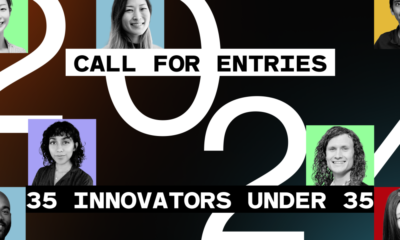Politics
Open Banking and the Internet of Things: a Collaboration for the Future
Published
2 years agoon
By
Drew Simpson
In the 21st century, Internet of Things (IoT) devices are used globally by various age groups to establish seamless communication between people, processes, and objects. People have wide access to IoT devices, and in turn, IoT technology has gained access to the consumers using low-cost computing, the cloud, large quantities of data, and analytics to collect and share data on clients.
These pieces of innovative tech are desirable to the consumer, with more than 7 billion connected IoT devices registered today. In fact, users are the ones shaping the industry with demands for productivity and optimized experiences being the driving force behind the creation of these devices and the astronomical adoption rates of the tech, with an average 90% adoption rate globally.
The integrated sensors of IoT devices are able to monitor and track data in real-time, with the findings being digitally transmitted via an IoT gateway or other devices, stored, and then can be accessed within any time period. The devices also have the ability to act on the information shared between them, to further enhance customer experience.
While IoT is commonly used within homes through appliances, the technology has further expanded into other areas of our lives, connecting with the financial industry and open banking.
Current finance innovations fuelled by IoT
IoT has already entered and revolutionized the finance industry through countless innovations. IoT-powered contactless payment solutions being one of the most widely used IoT enabled innovation in the industry, allowing customers to leave fumbling for their wallet in the past, instead allowing wearable tech, such as smartwatches to make quick payments, without entering PIN codes.
AI-powered banking through voice assistants, such as Alexa, Google Assistant, and Cortana, has further improved and simplified the process of online payments to e-commerce locations. Both options are quicker for the consumer and are more convenient, improving user experience.
Contactless payments, especially, were popularised through the COVID-19 pandemic with fears of contaminated surfaces pushing customers to opt for the “cleaner” touch-free solution. Mastercard’s study found a steep increase in contactless payments at grocery stores and pharmacies at the start of the pandemic in 2020, with statistics showcasing how touch-free transactions grew twice as fast as non-contactless.
Some banking institutions are utilizing Internet of Things technologies to transform identity verification into the simplest possible procedure, through visual identification tactics, such as submitting selfies from a smartphone. This results in clients receiving user IDs in the fastest way possible and without the danger of a data leak.
Shinhan Card, Korea’s leading bank card firm, is one of these innovators, intending to develop an IoT-based payment system that will include facial recognition technology. Once this is organized, the business will be able to further streamline the client experience, while also aiding in global eco-friendly initiatives by reducing the usage of plastic that is used in the creation of physical bank cards.
Data gathering and better customer experience
Both open banking and IoT are able to gather valuable data from customers and supply this information to relevant businesses. While the information obtained by open banking platforms is related to financial transactions which aid in creating a customer profile, IoT is able to provide additional insights in relation to lifestyle choices and day-to-day schedules. Using this data, businesses can adapt to clients’ needs and habits relying on new and always updating customer information.
Current client and consumer behavior dictates that technology, both in finance and within general client-based industries needs to be quick, more intuitive, increasingly tailored, and safe. Combining forces, open banking, and IoT can help gather information on all aspects of their clients’ lives, helping modernize and upgrade current systems in place, providing better customer experiences, fast solutions, and improved overall services.
Banks turn to IoT solutions as well, linking bank accounts to appliances to gather data and to facilitate related payments. For example, a refrigerator with the capabilities of direct grocery purchasing could be used by a customer paying directly through their linked bank account. Linking to accounts also provides banks with a significant edge giving them additional information and including them in key financial choices.
Simpler creditworthiness checks and insurance claims
Insurance companies and lenders can also take advantage of the combined amounts of data gathered through both sources. For years, insurance firms and loan companies have made judgments and performed creditworthiness checks based on historical data and outdated information stored within credit bureau databases to manage uncertainty and risk, calculating risk by analyzing information on prior customers and their general behaviors.
However, the tremendous rise of the Internet of Things data, collected and stored in near real-time, has the potential to fully restructure this system. The sensors and software present in IoT devices can supply insurers and lenders with real-time data on nearly everything relating to their customers’ day-to-day lives, including daily schedules, driving habits, and fitness levels. Combining this information with financial data from open banking, insurance companies, lending platforms, and landlords would have the most up-to-date and comprehensive information on potential clients. Insurance claims could be filed more quickly, while credit checks could be performed almost instantly, supplying both the customer and business with accurate information based on all the data gathered.
In theory, with wearable technology or IoT-enabled vehicles, insurance claims could be submitted very quickly as well, with information about potential road accidents or bodily injuries being recorded by the devices. The data stored can then be shared with the relevant parties as evidence. This can be beneficial for both sides, with customers being able to support their claims and insurers being more protected from fraudulent reports.
AI assistance and further automation
The connection between open banking and IoT devices can further the aforementioned AI-assisted voice banking service, allowing Alexa, Cortana, and Google Assistant to link to bank accounts directly. This could also apply to wearable technology with built-in voice recognition software, such as Apple Watches. This will allow for financial data, such as the current balance, to be directly transmitted to the customer without them needing to log in to their online banking account every time they would like to check in with their finances. In theory, this can also further revolutionize the way vision-impaired individuals interact with their digital banks, allowing them to easily access and manage their funds as long as they already own an IoT device of this nature.
Automation is another priority factor and a characteristic that open banking and IoT both share. Open banking has allowed for third-party services to populate their applications with valuable financial data to automate processes within finance management, accounting procedures, Know Your Customer (KYC) verifications, identity authentication, and more.
Similarly, IoT already automatically processes requests, but with open banking, it can further help automate financial procedures, and instinctively disable accounts, transfer ownership of assets, and more. A real-life case study already showcasing this in our time is Chase Bank who, with the help of IoT, has reduced the time needed to open an account to five minutes.
Impact on personal finance management and investing tools
The data gathered from IoT devices is acquired in real-time through direct contact with consumers, making it one of the most reliable and up-to-date pieces of information on customer behavior. Combined with financial data obtained through open banking, personal finance management (PFM) applications, as well as investment tools can gather incredible insights on customer habits and spending.
Global data can be used to predict behaviors and put together plans that have been proven successful with similar clients. Additionally, information gathered across all the customer’s IoT devices can supply PFM apps and finance tools with more robust information on specific clients, helping create an even more personalized approach for each individual. The applications can take into account the lifestyle of the client, thoroughly analyze all the data, and put together a plan that is sustainable and achievable based on the gathered insights.
Fraud detection and protection
Internet of Things devices can be taken further to elevate levels of security and protection in regard to financing processes and systems. Open banking has previously been scrutinized for its potential to create financial safety risks, such as data breaches. As data becomes shared, consumers can become anxious about how well their financial information is protected, with 48% of customers surveyed in 2019 stating they were concerned about security when it comes to open banking.
Allowing users to link their objects to bank accounts can also lead to security concerns, with the accounts’ security levels only being as secure as the object itself. Anyone who can come into contact or possession of the object could theoretically access financial information or make unsolicited purchases.
Open banking has valuable security features set in place, such as Strong Customer Authentication (SCA) and Consent Management. Banks also add their own layer of security, with individual fraud protection protocols in place to protect customer data. IoT, however, is able to create more futuristic solutions to cybersecurity, focusing on helping financial institutions predict and identify security risks in real-time.
Facial recognition software and biometrics
Facial recognition technology and biometric identification processes are a couple of examples of security measures benefiting from the rise of IoT. Devices that are used to log into banking services or that are permanently linked to a bank account can use this technology to ensure that whoever accessing the account is the genuine owner of the device and the account.
Facial recognition may also be utilized outside of the login process, instead taking note of anyone with who it comes into contact. One application for this is loitering detection which when used in ATM or bank vestibules can recognize someone standing around for longer than a predetermined duration of time. When someone is identified as “loitering”, the stakeholder or account owner can be alerted by the system. While this is increasingly helpful in bank offices, a similar system can be further spread to individual objects, with multiple failed identification attempts through an IoT device alerting customers of a potential hack.
Other ways for IoT devices to help protect banking assets include the use of fingerprint identification, retinal scans, and FaceID in mobile applications to help ensure that there is no breach or unauthorized access. UK mobile bank, Atom, has created a security system that requires clients to go through a variation of either facial scans, passcodes, or voice recognition tests to be passed before any action can be performed on their account. This can be further spread to apply to IoT devices with linked banks.
IoT wristband Nymi takes identity verification even further by recording and storing customers’ unique heartbeats or heart “signature” to authenticate the wearer’s identity. The device must be placed in front of a supported scanner for the authentication process to commence. While Nymi is currently focused on innovations within employee verification at places of business, the idea can be implemented within financial services and identity authentication within banking. Nymi, or other innovations can continue to develop and create ways for customers to verify their identity and keep their financial data safe.
Final thoughts
The digital revolution is truly here, and it is driven by novel technologies such as open banking and IoT devices. Individually, they are both changing the way consumers and businesses communicate with each other and helping commercial industries innovate. Both prioritize a simpler, more enjoyable user experience and the utilization of customer data for the benefit of the consumers. With the open banking industry and the IoT market joining forces, real magic can happen, bringing out new innovations and ideas, and paving the way for more fintech inventions.
Rolands Mesters
CEO and co-founder of Nordigen
Rolands Mesters is the CEO and co-founder of Nordigen, the first free open banking API that provides the widest reach of European bank connections. Passionate about fintech and advocating innovation through free open banking, Rolands regularly shares industry insights, featured by top media outlets.
You may like
-


Chinese apps are letting public juries settle customer disputes
-


Users are doling out justice on a Chinese food delivery app
-


The Download: COP28 controversy and the future of families
-


The 2024 35 Innovators Under 35 competition is now open for nominations
-


Exclusive: Ilya Sutskever, OpenAI’s chief scientist, on his hopes and fears for the future of AI
-


How heat batteries promise a cleaner future in industrial manufacturing
Politics
Fintech Kennek raises $12.5M seed round to digitize lending
Published
7 months agoon
10/11/2023By
Drew Simpson
London-based fintech startup Kennek has raised $12.5 million in seed funding to expand its lending operating system.
According to an Oct. 10 tech.eu report, the round was led by HV Capital and included participation from Dutch Founders Fund, AlbionVC, FFVC, Plug & Play Ventures, and Syndicate One. Kennek offers software-as-a-service tools to help non-bank lenders streamline their operations using open banking, open finance, and payments.
The platform aims to automate time-consuming manual tasks and consolidate fragmented data to simplify lending. Xavier De Pauw, founder of Kennek said:
“Until kennek, lenders had to devote countless hours to menial operational tasks and deal with jumbled and hard-coded data – which makes every other part of lending a headache. As former lenders ourselves, we lived and breathed these frustrations, and built kennek to make them a thing of the past.”
The company said the latest funding round was oversubscribed and closed quickly despite the challenging fundraising environment. The new capital will be used to expand Kennek’s engineering team and strengthen its market position in the UK while exploring expansion into other European markets. Barbod Namini, Partner at lead investor HV Capital, commented on the investment:
“Kennek has developed an ambitious and genuinely unique proposition which we think can be the foundation of the entire alternative lending space. […] It is a complicated market and a solution that brings together all information and stakeholders onto a single platform is highly compelling for both lenders & the ecosystem as a whole.”
The fintech lending space has grown rapidly in recent years, but many lenders still rely on legacy systems and manual processes that limit efficiency and scalability. Kennek aims to leverage open banking and data integration to provide lenders with a more streamlined, automated lending experience.
The seed funding will allow the London-based startup to continue developing its platform and expanding its team to meet demand from non-bank lenders looking to digitize operations. Kennek’s focus on the UK and Europe also comes amid rising adoption of open banking and open finance in the regions.
Featured Image Credit: Photo from Kennek.io; Thank you!
Radek Zielinski
Radek Zielinski is an experienced technology and financial journalist with a passion for cybersecurity and futurology.
Politics
Fortune 500’s race for generative AI breakthroughs
Published
7 months agoon
10/11/2023By
Drew Simpson
As excitement around generative AI grows, Fortune 500 companies, including Goldman Sachs, are carefully examining the possible applications of this technology. A recent survey of U.S. executives indicated that 60% believe generative AI will substantially impact their businesses in the long term. However, they anticipate a one to two-year timeframe before implementing their initial solutions. This optimism stems from the potential of generative AI to revolutionize various aspects of businesses, from enhancing customer experiences to optimizing internal processes. In the short term, companies will likely focus on pilot projects and experimentation, gradually integrating generative AI into their operations as they witness its positive influence on efficiency and profitability.
Goldman Sachs’ Cautious Approach to Implementing Generative AI
In a recent interview, Goldman Sachs CIO Marco Argenti revealed that the firm has not yet implemented any generative AI use cases. Instead, the company focuses on experimentation and setting high standards before adopting the technology. Argenti recognized the desire for outcomes in areas like developer and operational efficiency but emphasized ensuring precision before putting experimental AI use cases into production.
According to Argenti, striking the right balance between driving innovation and maintaining accuracy is crucial for successfully integrating generative AI within the firm. Goldman Sachs intends to continue exploring this emerging technology’s potential benefits and applications while diligently assessing risks to ensure it meets the company’s stringent quality standards.
One possible application for Goldman Sachs is in software development, where the company has observed a 20-40% productivity increase during its trials. The goal is for 1,000 developers to utilize generative AI tools by year’s end. However, Argenti emphasized that a well-defined expectation of return on investment is necessary before fully integrating generative AI into production.
To achieve this, the company plans to implement a systematic and strategic approach to adopting generative AI, ensuring that it complements and enhances the skills of its developers. Additionally, Goldman Sachs intends to evaluate the long-term impact of generative AI on their software development processes and the overall quality of the applications being developed.
Goldman Sachs’ approach to AI implementation goes beyond merely executing models. The firm has created a platform encompassing technical, legal, and compliance assessments to filter out improper content and keep track of all interactions. This comprehensive system ensures seamless integration of artificial intelligence in operations while adhering to regulatory standards and maintaining client confidentiality. Moreover, the platform continuously improves and adapts its algorithms, allowing Goldman Sachs to stay at the forefront of technology and offer its clients the most efficient and secure services.
Featured Image Credit: Photo by Google DeepMind; Pexels; Thank you!
Deanna Ritchie
Managing Editor at ReadWrite
Deanna is the Managing Editor at ReadWrite. Previously she worked as the Editor in Chief for Startup Grind and has over 20+ years of experience in content management and content development.
Politics
UK seizes web3 opportunity simplifying crypto regulations
Published
7 months agoon
10/10/2023By
Drew Simpson
As Web3 companies increasingly consider leaving the United States due to regulatory ambiguity, the United Kingdom must simplify its cryptocurrency regulations to attract these businesses. The conservative think tank Policy Exchange recently released a report detailing ten suggestions for improving Web3 regulation in the country. Among the recommendations are reducing liability for token holders in decentralized autonomous organizations (DAOs) and encouraging the Financial Conduct Authority (FCA) to adopt alternative Know Your Customer (KYC) methodologies, such as digital identities and blockchain analytics tools. These suggestions aim to position the UK as a hub for Web3 innovation and attract blockchain-based businesses looking for a more conducive regulatory environment.
Streamlining Cryptocurrency Regulations for Innovation
To make it easier for emerging Web3 companies to navigate existing legal frameworks and contribute to the UK’s digital economy growth, the government must streamline cryptocurrency regulations and adopt forward-looking approaches. By making the regulatory landscape clear and straightforward, the UK can create an environment that fosters innovation, growth, and competitiveness in the global fintech industry.
The Policy Exchange report also recommends not weakening self-hosted wallets or treating proof-of-stake (PoS) services as financial services. This approach aims to protect the fundamental principles of decentralization and user autonomy while strongly emphasizing security and regulatory compliance. By doing so, the UK can nurture an environment that encourages innovation and the continued growth of blockchain technology.
Despite recent strict measures by UK authorities, such as His Majesty’s Treasury and the FCA, toward the digital assets sector, the proposed changes in the Policy Exchange report strive to make the UK a more attractive location for Web3 enterprises. By adopting these suggestions, the UK can demonstrate its commitment to fostering innovation in the rapidly evolving blockchain and cryptocurrency industries while ensuring a robust and transparent regulatory environment.
The ongoing uncertainty surrounding cryptocurrency regulations in various countries has prompted Web3 companies to explore alternative jurisdictions with more precise legal frameworks. As the United States grapples with regulatory ambiguity, the United Kingdom can position itself as a hub for Web3 innovation by simplifying and streamlining its cryptocurrency regulations.
Featured Image Credit: Photo by Jonathan Borba; Pexels; Thank you!
Deanna Ritchie
Managing Editor at ReadWrite
Deanna is the Managing Editor at ReadWrite. Previously she worked as the Editor in Chief for Startup Grind and has over 20+ years of experience in content management and content development.
